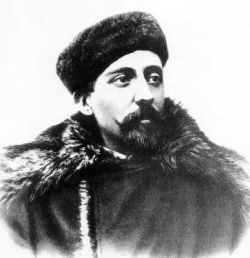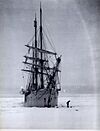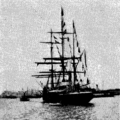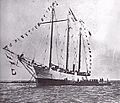List of Antarctic exploration ships from the Heroic Age, 1897–1922 facts for kids

This article is about the amazing ships that explored Antarctica between 1897 and 1922. This time is known as the Heroic Age of Antarctic Exploration. These ships helped brave explorers reach the icy continent and discover new lands. We'll also look at some important support ships that helped these expeditions.
Not all ships that went to the Antarctic are on this list. For example, regular whaling ships are not included. Also, expeditions that didn't actually go into the Antarctic Circle (the imaginary line around Antarctica) are left out.
It's cool to know that three of these historic ships are still around today! You can visit the Discovery in Dundee, Scotland, the Fram in Oslo, Norway, and the Uruguay in Buenos Aires, Argentina. Sadly, some ships like Antarctic and Endurance were lost during their journeys. Others were taken apart or sank years later. The story of the Japanese ship Kainan Maru is still a mystery!
Main Expedition Ships
These are the main ships that carried explorers on their daring journeys to Antarctica.
| Ship Name (Country) |
Size (GRT) | Image | Expedition | Leader | What Happened Next |
|---|---|---|---|---|---|
| Belgica (formerly Patria) |
263 |  |
Belgian Antarctic Expedition 1897–1899 | Adrien de Gerlache | After its Antarctic trip, Belgica was used for many different jobs. It became a research ship, then a coal carrier, and even a floating fish factory! During Second World War, it was used to store ammunition. Sadly, it was sunk by German planes in 1940. Its wreck was found again in 1990. |
| Southern Cross (formerly Pollux) |
521 |  |
British Antarctic Expedition (Southern Cross Expedition) 1898–1900 | Carsten Borchgrevink | In 1901, Southern Cross was sold and became a ship for seal hunting. It worked this job until 1914. Then, it was lost in a terrible storm near Newfoundland, Canada. All 173 people on board were lost. One idea is that its heavy cargo of seal furs shifted and made the ship flip over. This was the biggest loss of life in Newfoundland's sealing history. |
| Discovery |
736 |  |
National Antarctic Expedition (Discovery Expedition) 1901–1904 | Robert Falcon Scott | Discovery was bought by the Hudson's Bay Company in 1905 and used to carry goods. During First World War, it was a supply ship. In 1916, it briefly helped search for Ernest Shackleton. Later, it was used for ocean research. In 1929, it went back to Antarctica with Douglas Mawson. After that, it became a training center for Scouts in London. In 1979, it became a museum ship. In 1986, it moved to Dundee, Scotland, where it is now a permanent exhibition. |
| Gauss |
728 |  |
First German Antarctic Expedition (Gauss Expedition) 1901–1903 |
Erich von Drygalski | In 1905, the Canadian government bought Gauss and renamed it CGS Arctic. It had a long career exploring the Canadian Arctic. After a break during First World War, it continued its Arctic journeys until 1925. The ship was then sold and taken apart, with its hull left on a sandbank. |
| Antarctic (formerly Kap Nor) |
346 |  |
Swedish Antarctic Expedition 1901–1903 | Otto Nordenskiöld | Antarctic did not survive its expedition. In early 1903, it got stuck in thick pack ice near the Antarctic Peninsula. The ship was badly damaged and sank on February 12, 1903. Luckily, all the crew members were rescued safely. |
| Scotia (formerly Hekla) |
375 |  |
Scottish National Antarctic Expedition 1902–1904 | William Speirs Bruce | Scotia was sold and went back to hunting seals near Greenland. In 1913, it helped patrol for icebergs in the North Atlantic. During First World War, it was used by the French government to carry goods. On January 18, 1916, it caught fire and was destroyed near Sully Island in the Bristol Channel. |
| Français |
250 | Third French Antarctic Expedition 1903–1905 | Jean-Baptiste Charcot | After the expedition, Français was sold to the Argentine government and renamed Austral. In December 1907, the ship was wrecked on a sandbank in the Río de la Plata (River Plate). | |
| Nimrod |
458 |  |
British Antarctic Expedition 1907 (Nimrod Expedition) 1907–1909 | Ernest Shackleton | When Shackleton returned to England in 1909, he used Nimrod as a "floating museum" to show off items from the expedition. He later sold it to help pay off the expedition's debts. For a few years, it carried coal. On January 31, 1919, Nimrod was wrecked and destroyed in the North Sea. Ten of its twelve crew members were lost. |
| Pourquoi-Pas? IV |
445 |  |
Fourth French Expedition 1908–1910 | Jean-Baptiste Charcot | The French Navy used Pourquoi-pas? as a training ship during First World War. After the war, Charcot took command again and led many science missions. In 1928, the ship helped search for Roald Amundsen, who disappeared in the Arctic. On September 16, 1936, while sailing near Iceland, Pourquoi-pas? was caught in a big storm and wrecked. Only one crew member survived, and Charcot was among those lost. |
| Kainan Maru (formerly Hoko Maru) |
204 |  |
Japanese Antarctic Expedition 1910–1912 | Nobu Shirase | After the expedition, Kainan Maru was sold back to its old owners and went back to fishing. The leader, Nobu Shirase, spent many years raising money to pay off the expedition's debts. He died in 1946. The ship might have been sunk in 1944 by a US air attack, but no one knows for sure. |
| Fram |
402 |  |
Amundsen's South Pole expedition 1910–1912 | Roald Amundsen | Amundsen had plans for Fram after his South Pole trip, but First World War stopped them. Fram was left to decay for many years. In 1925, people started working to save the ship. Restoration began in 1929. Finally, in 1935, the restored Fram was brought to Oslo, Norway, and placed in a special building. Today, it is a famous museum ship. |
| Terra Nova |
744 |  |
British Antarctic Expedition 1910 (Terra Nova Expedition) 1910–1913 |
Robert Falcon Scott | After returning from Antarctica in 1913, Terra Nova was bought back by its previous owners. It worked as a sealer from 1913 to 1942. During Second World War, it was a supply ship. On September 12, 1943, the ship was damaged and started leaking badly. Its crew and important items were moved to another ship. The next day, the damaged ship was set on fire and sunk by gunfire. In 2012, the wreck of Terra Nova was discovered! |
| Deutschland (formerly Bjørn) |
598 |  |
Second German Antarctic Expedition 1911–1914 | Wilhelm Filchner | After Deutschland returned to Germany, it was sold and renamed Osterreich. An Austrian expedition was planned, but First World War broke out and it was cancelled. The ship was then used by the Austro-Hungarian Navy as a minesweeper. It was sunk by a torpedo in the Adriatic Sea in 1917. |
| Aurora |
386 |  |
Australasian Antarctic Expedition 1911–1914 | Douglas Mawson | At the end of this expedition, Aurora was sold to Sir Ernest Shackleton for £3,200. He wanted to use it for the Ross Sea party part of his Imperial Trans-Antarctic Expedition. |
| Endurance (formerly Polaris) |
350 |  |
Imperial Trans-Antarctic Expedition 1914–1917 | Ernest Shackleton | Endurance got stuck in the ice of the Weddell Sea. It was crushed and had to be abandoned on October 27, 1915, and later sank. The crew bravely made their way across the ice and in small boats to Elephant Island. They were eventually rescued. The wreck of Endurance was discovered on March 5, 2022! |
| Aurora |
 |
Ross Sea party 1914–1917 (supporting the Imperial Trans-Antarctic Expedition) | Aeneas Mackintosh | After rescuing the Ross Sea party, Aurora was sold for £10,000. On June 17, 1917, it sailed with a cargo of coal and was never seen again. A lifebelt with Aurora's name was found later. No one knows for sure what happened to the ship, but bad weather or enemy action are possible reasons. | |
| Quest (formerly Foca I) |
205 |  |
Shackleton–Rowett Expedition | Ernest Shackleton | After the expedition, Quest was sold and used as a sealer and Arctic research ship until 1940. In 1928, it helped search for Umberto Nobile, who was missing in the Arctic. In 1930, it explored possible air routes to Canada. During Second World War, Quest was used by the Allied navies. In 1946, it went back to sealing until May 5, 1962, when it got stuck in ice and sank off the coast of Labrador. |
Important Support and Rescue Ships
These ships played vital roles in helping the main expeditions, often bringing supplies or rescuing stranded explorers.
| Ship Name | Captain | Image | Expedition Supported | Its Story |
|---|---|---|---|---|
| Morning |
William Colbeck |  |
National Antarctic Expedition (Discovery Expedition) 1901–1904 | Morning was built in 1871 as an Arctic whaler. It made two trips to Antarctica to help the Discovery Expedition. In 1903, it brought fresh supplies but couldn't free Discovery from the ice. In 1904, with another ship called Terra Nova, Discovery was finally freed. After its Antarctic missions, Morning went back to whaling. It was lost during a storm in the North Atlantic on December 24, 1915. |
| Uruguay |
Julián Irízar |  |
Swedish Antarctic Expedition 1901–1903 | Built in England in 1874, Uruguay served the Argentine Navy for many years before becoming an Antarctic rescue ship. Under Captain Julián Irízar, it successfully rescued Otto Nordenskiöld's expedition. Between 1903 and 1922, Uruguay made 13 more rescue trips to Antarctica. After it retired, it became a museum ship in Buenos Aires, where you can visit it today. |
| Koonya |
Frederick Pryce Evans | Nimrod Expedition 1907–1909 | Koonya was a steam cargo ship built in 1898. In 1908, it towed Nimrod from New Zealand to the Antarctic Circle. This saved Nimrod's coal. According to Shackleton, Koonya was the first steel ship to cross the Antarctic Circle. On June 3, 1919, Koonya ran aground in Tasmania and was wrecked. All its crew members were safe. | |
| Yelcho |
Luis Pardo |  |
Imperial Trans-Antarctic Expedition 1914–1917 | Shackleton tried three times to rescue the Endurance crew stuck on Elephant Island. For the fourth try, he used the Chilean naval tug Yelcho, led by Captain Luis Pardo. Yelcho sailed on August 25, 1916, and reached Elephant Island on August 30, thanks to calm seas. The rescue was a success! Yelcho then returned to its naval duties until 1945. It was finally taken apart in 1962. To honor its rescue, the front part of the ship is now part of a monument in Puerto Williams, Chile. |
See also
- Heroic Age of Antarctic Exploration

